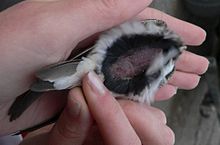Breeding spot
A breeding spot (area incubationis) is a skin area on the front belly of breeding birds that is free of small plumage and is extremely well supplied with blood, which enables optimal transfer of body heat to the clutch.
number
Most bird species, such as passerines or birds of prey , have only one nesting spot. Skuas , auks, and plovers usually have two, while most gulls , ducks, and geese develop three breeding spots. Pelicans , boobies , penguins and cormorants have no breeding spots.
education
In almost all birds, the development of the nesting spot is hormonally controlled, in that towards the end of the egg-laying of the bird that mainly incubates the clutch, the feathers in the area of body-egg contact fall out. Some species, such as geese and ducks, remove the dunes active and use them for padding and insulation of the nest. In almost all birds the feathers grow back after the breeding business has ended, in a few others, for example in many pigeons , the breeding spot remains permanently; the bald patch of skin is only covered by the large plumage .
literature
- E. Bezzel, R. Prinzinger: Ornithology . 2nd Edition. Ulmer-Stuttgart, 1990, ISBN 3-8001-2597-8 .
